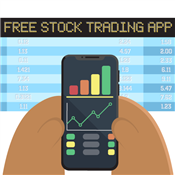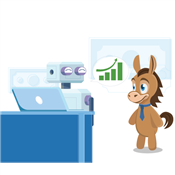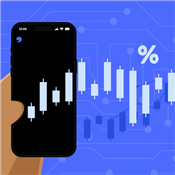Best Investment Accounts
Looking to open an investment account? In this list, review the best investment accounts to choose from and how to pick the right one for you.
 |
J.P. Morgan Self-Directed Investing - Get Up to $700
- Get up to $700 when you open and fund a J.P. Morgan Self-Directed Investing account with qualifying new money.
- $700 when you fund with $250,000 or more
- $325 when you fund with $100,000-$249,999
- $150 when you fund with $25,000-$99,999
- $50 when you fund with $5,000-$24,999
- Get unlimited commission-free online stock, ETF, fixed income, and options trades when you open an account.
- $0 Online Commission trades
- Choose an account that's right for you: General Investing, Traditional IRA or Roth IRA.
- Access our secure, easy-to-use trading experience online or through the Chase Mobile® app.
- Our powerful tools and resources are built to help you take control of your investments.
INVESTMENT AND INSURANCE PRODUCTS ARE:
Fund and Get 2% Match Bonus
Enroll in this offer and complete one or more qualifying deposits of $2,000 or more into your Webull account. Maintain the funds in your account until the payment date of the final installment of the match bonus. The 2% match bonus will be automatically credited to your eligible Webull account in 12 equal monthly installments.
$20 Investment Bonus
- Open an Acorns account (new users only)
- Set up the Recurring Investments feature
- Have your first investment be made successfully via the Recurring Investments feature
People say that you should start investing as soon as possible.
But getting started can be a daunting task.
While your investments are up to you, this guide can help you choose the best investment account to get the ball rolling. Plus, learn about which account type is best suited for your goals.
Best Investment Accounts
 |
The options featured below are some of the best-known in investing today.
Take a look at how they differ, and you'll be well on your way to picking the investment account that's right for you.
| Annual Fee | Minimum Deposit | ||
|---|---|---|---|
| Wealthfront | 0.25% | $500 | Learn More |
| Betterment |
| $0 | Learn More |
| Robinhood | Starts at $0 | $0 | Learn More |
| J.P. Morgan Wealth Management | $0 | $0 | Learn More |
| Public.com | Starts at $0 | $0 | Learn More |
| M1 Finance | A $3 monthly platform fee will apply to clients with less than $10,000 in M1 assets or without an active M1 Personal Loan. | $100 ($500 for IRAs, $5,000 for Trust Account) | Learn More |
| E*TRADE | None | $0 for self-directed brokerage accounts; Managed portfolios start at $500 minimum | Learn More |
| Vanguard | $25 | $0 | Learn More |
| Webull | Starts at $0 | $0 | Learn More |
| Fidelity | None | $0 | Learn More |
| Acorns |
| $0 | Learn More |
1. Wealthfront
|
|
New investors may be interested in Wealthfront, an automated investing platform with low fees. It costs just $500 to start, and they'll only charge a 0.25% annual advisory fee.
They'll make trades for you (if you want) and rebalance your portfolio when necessary.
Wealthfront can also help you choose an investing path suited to your interests. They offer curated portfolios like their "Socially Responsible" portfolio, which addresses issues like human rights, climate change, diversity and equity.
Other portfolios you can choose from include Technology ETFs, Cannabis ETFs, and Healthcare ETFs. You can also get help transferring portfolios from other brokerages and save on taxes doing it.
Of course, you don't have to rely on their curated investment picks. You're free to add and remove investments on your own as well.
If you're interested in investing in crypto but not necessarily buying cryptocurrency itself, you can also take advantage of access to Blackrock's iShares Bitcoin and Ethereum trusts, which can make up to 10% of your portfolio.
Key Features:
- Automated investing accounts
- Curated portfolios
- Cash account with ATM withdrawals
- Traditional IRA, Roth IRA, SEP IRA, 401(k), 529 College Savings Accounts
- Individual Accounts, Joint Accounts, Trust Accounts
- Mobile app
- SIPC Insured
Fees & Minimums[1]
- $500 minimum
- Free trading
- 0.25% annual advisory fee
Wealthfront Cash Account
- 4.00% APY on all your cash
- $0 monthly fees
- No overdraft fees
- Wealthfront is not a bank. Funds held in Wealthfront Cash Account are FDIC-insured up to $8 million through partner banks.
2. Betterment
|
|
Betterment is a popular robo-advisor that uses automated software to manage your portfolio. There's no minimum balance, meaning you can get started investing with just $10.
They do charge a 0.25% annual fee, similar to other automated investing platforms like Wealthfront. But if your total Betterment balance is below $20,000 or you don't have a recurring deposit of at least $250 per month, Betterment will charge you $4 per month rather than a 0.25% annual fee.
You can let them manage your account entirely, or you can DIY and choose your own investments.
With Betterment, you invest in a variety of ETFs (exchange-traded funds), which give your portfolio more diversity than investing in individual stocks, meaning less volatility. You can customize your account by setting your risk tolerance, savings goals, and more.
Like Wealthfront, they also have a "Socially Responsible" investment portfolio. They'll do what they can to help you save on taxes, and even let you track your finances in one place when you connect outside accounts.
They even provide a fee-free checking account with ATM withdrawals and mobile deposits through their app.
Key Features:
- Robo-advisor
- Free checking account with ATM withdrawals
- Traditional IRA, Roth IRA, Roth Conversion IRA, SEP IRA, 401(k), High-Yield Cash Accounts
- Trusts
- Mobile app
- Low-cost trading
- SIPC Insured
Fees & Minimums[2]
- $4/month for accounts less than $20,000; or 0.25% annual fee for balances of $20,000 or more, or with a recurring monthly deposit of $250 or more
- No account minimum
Betterment: Compare Pricing
3. Robinhood
|
|
Robinhood is an investing app that aims to democratize stock trading by making it quick and easy to get started.
As a commission-free exchange with fractional shares, Robinhood has removed many of the financial barriers to get into stock trading. Their intuitive, user-friendly design makes it easy to get started, too.
Investors in the United States can trade stocks listed on the NASDAQ and New York Stock Exchange (NYSE), as well as a range of popular stocks from international exchanges. Robinhood also offers a limited range of cryptocurrencies, including the most popular like Bitcoin and Ethereum.
Key Features:
- Fractional shares
- Easy to use
- Real-time market data
- Extended trading hours
- Free cash card account
- SIPC protected
- Mobile app
- Limited crypto trading
- 24/7 customer support online and by phone
Fees & Minimums:[3]
- 100% commission-free
- No minimums
4. J.P. Morgan Self-Directed Investing
|
|
J.P. Morgan Self-Directed Investing accounts offer unlimited commission-free trading online or through their mobile app.
You can choose from a wide variety of investment options, including stocks, ETFs, mutual funds, and options. Their portfolio builder tool also lets you customize your investment strategy. Fractional shares are also available for as little as $5.
When you sign up, you'll get access to J.P. Morgan Research, which provides market analysis and news.
They offer a range of investment and savings account types, including a general investment account and traditional and Roth IRAs.
If you want to level up your investing, you can work directly with a J.P. Morgan Advisor.
Key Features:
- Unlimited trades
- Trade stocks, ETFs, mutual funds, and options
- Market analysis and news
- General Investment, Traditional IRA, Roth IRA accounts
- J.P. Morgan Advisor
- Fractional shares
Fees & Minimums
- $0 account minimum
- Commission-free trading
J.P. Morgan Self-Directed Investing - Get Up to $700
- Get up to $700 when you open and fund a J.P. Morgan Self-Directed Investing account with qualifying new money.
- $700 when you fund with $250,000 or more
- $325 when you fund with $100,000-$249,999
- $150 when you fund with $25,000-$99,999
- $50 when you fund with $5,000-$24,999
- Get unlimited commission-free online stock, ETF, fixed income, and options trades when you open an account.
- $0 Online Commission trades
- Choose an account that's right for you: General Investing, Traditional IRA or Roth IRA.
- Access our secure, easy-to-use trading experience online or through the Chase Mobile® app.
- Our powerful tools and resources are built to help you take control of your investments.
INVESTMENT AND INSURANCE PRODUCTS ARE:
5. Public
|
|
Public is an investing social network. Their goal is to make investing accessible by promoting financial literacy and education, and offering fractional shares of expensive stocks.
Public focuses on stock trading and ETFs, and you can get started with as little as $1.00. Public is free to download and commission-free as well.
As a trading social network, Public stands out for giving you the ability to see what others are trading. This can help you make more informed decisions on what to invest in.
Users can also follow curated themes. These groups of stocks share unifying features. Examples include The Crypto Revolution, For the Win! (gaming and eSports), Women in Charge, and Growing Diversity.
Key Features:
- Over 9,000 stocks and ETFs
- Curated theme-based portfolios
- Collaborative community
- Fractional shares
- Fund account with debit card
- Mobile app
- SIPC insured
Fees & Minimums[4]
- Commission-free trading
- No deposit or withdrawal fees
- No minimum to open account
6. M1 Finance
|
|
M1 Finance offers a variety of financial services to investors, and there are no trading commissions. M1 is not a robo-advisor and only offers self-directed brokerage services.
Their investing accounts offer fractional shares and automatic rebalancing, with automation capabilities so you don't have to worry about making trades manually if you don't want to.
And if you want to invest like an expert, you can choose from one of their curated "pies," each following its own unique investing strategy.
You can take out a line of credit against your investments, avoiding selling and taxes if you're faced with a big expense.
They offer a rewards credit card that gives cash back rewards on eligible purchases.
Users are able to set up smart transfers that will complete automatically if set criteria are met, and send physical checks without having to write them by hand.
Key Features:
- Individual taxable accounts, joint accounts, custodial accounts, traditional, Roth, SEP IRAs, trust accounts, and crypto accounts
- Automated trading
- Model Portfolios
- Credit line
- Rewards card
- Mobile app
Fees & Minimums[5]
- Commission-Free
- $100 minimum
- A $3 monthly platform fee will apply to clients with less than $10,000 in M1 assets or without an active M1 Personal Loan.
M1 Finance: Commission Free Stock Trading
M1 Finance allows investors the choice of ETFs and stocks. M1 charges $0 commission fees on trading
7. E*TRADE
|
|
E*Trade is a popular online brokerage that caters to beginners and low-frequency traders. They have a wide range of investment accounts available compared to many of their competitors.
Their brokerage accounts include a normal trading and investing account, Coverdell ESAs for education, and custodial accounts for minors.
E*Trade offers a wide selection of IRAs, including Traditional and Roth IRAs, Rollover IRAs from old 401(k)s, Beneficiary IRAs for inherited retirement assets, E*Trade Complete IRAs for investors over 59 1/2, and IRAs for minors.
They also offer 401(k)s, SIMPLE and SEP IRAs, as well as profit-sharing and investment accounts for small businesses.
You can even apply for a mortgage through E*Trade.
Key Features:
- Extensive brokerage and retirement accounts
- Banking services, including checking and savings
- Trade stocks, options, futures, mutual funds, ETFs, bonds and CDs
- Prebuilt or managed portfolios
- Investing guidance
- Mobile app
Fees & Minimums[6]
- No minimum to open an E*TRADE brokerage account; $500 minimum initial investment in robo-advisor platform Core Portfolios
- Commission-free trading
8. Vanguard
|
|
Vanguard is a platform best for active investors interested in building and managing their own portfolios.
They offer a range of options for investors or those planning for retirement, including Traditional and Roth IRAs, individual and joint accounts, 529 plans for education, as well as small business retirement plans.
Their range of investment options is extensive as well, including mutual funds, ETFs, stocks, CDs and bonds, and money market funds. Vanguard was one of the earliest companies to offer low-cost investing and has lower fees than many of their competitors.
Investing with Vanguard does require a little more expertise than some of these other options, as you'll be picking your own investments, many of which have minimum requirements of at least $1,000.
The good news is they also offer help, either in the form of their Vanguard Personal Advisor Services, or with the Vanguard Digital Advisor, an online financial planner that helps you choose an investment strategy.
Key Features:
- Trade mutual funds, ETFs, stocks, CDs and bonds, money market funds, ESG funds
- Traditional and Roth IRAs, individual and joint accounts, 529 plans, small business retirement plans, one-person SEP-IRAs, 403(b)s
- Advisor services
- Robo-advisor
- Mobile app
Fees & Minimums[7]
- Low-fee trading
- $25 annual service fee (can be waived easily)
- Some investments require a $1,000 minimum
Vanguard: Norton Internet Security 60-day free subscription
Registered users of Vanguard get a complimentary 60-day subscription to Norton Internet Security. After your subscription has ended, you can purchase the security software at a special price. Norton Internet Security is a leading security software package that protects your computer and network from viruses, hackers, spywares, and phishing attempts.
9. Webull
|
|
Webull is another popular investing platform, especially with millennials. They offer a wide range of investment options, including stocks, ETFs, and options, and trading is all commission-free. They have no deposit minimums either.
They have a range of investment accounts, including Traditional and Roth IRAs and Individual Brokerage Accounts. They support full extended trading hours, and you can trade via app or PC.
One feature that sets Webull apart is its extensive research and analytical tools, which many retail investor-oriented platforms aren't known for.
For those looking to learn, they offer a free paper trading account that allows you to play around with unlimited fake money. You get 3 trades per 5-day period, a restriction lifted for accounts over $25,000. Short selling and options trading are also available.
Key Features:
- Free extended trading accounts
- Free margin account with $2,000 minimum
- Trading Simulator
- Advanced research tools and charting
- Trade stocks, ETFs, and options
- Mobile app
- Fractional shares
Fees & Minimums[8]
- Commission-free trades
- No account minimums
Fund and Get 2% Match Bonus
Enroll in this offer and complete one or more qualifying deposits of $2,000 or more into your Webull account. Maintain the funds in your account until the payment date of the final installment of the match bonus. The 2% match bonus will be automatically credited to your eligible Webull account in 12 equal monthly installments.
10. Fidelity
|
|
Fidelity is another well-known stock exchange that has something to offer for beginners and experts alike.
You can invest in a wide range of securities, including stocks, mutual funds, ETFs, bonds, and CDs.
They also offer IRA accounts, 529 college savings accounts, or cash management accounts. Normal trades are commission-free.
Fidelity offers a quick look at your "retirement score" to see if you're on track to meet your goals, access to an estate planner that will help you find an attorney, and tools to help choose a trading strategy that is right for you.
Key Features:
- Trade stocks, mutual funds, ETFs, bonds, and CDs
- Financial planning assistance
- IRA accounts, 529 college savings accounts, or cash management accounts
- Mobile app
- In-depth research tools
- Article and video archive
Fees & Minimums[9]
- Commission-free trading
- $0 minimum deposit
- No annual fee
11. Acorns
|
|
Acorns is an investing app that aims to make it easy for average people to level up their finances. You can fund your account by rounding up the spare change on your purchases and putting it away to save or invest.
Setup on investment accounts for the whole family is quick and easy, and they also offer retirement and checking accounts that users can add to incrementally.
Users can take advantage of portfolios designed by experts that automatically adjust to keep their investments on track.
Key Features:
- Round up spare change
- Investment, Retirement, and Checking accounts
- Roth, Traditional, SEP IRAs
- UTMA / UGMA accounts for minors
- ESG portfolios
- Pre-built portfolios of stocks, ETFs, and bonds
- Investor risk assessment
- Investing for kids
- Mobile app
- IRA match
Fees & Minimums[10]
- Accounts incur a monthly fee of $3 to $12
- Trading fee factored into the monthly service fee
- No withdrawal fees
$20 Investment Bonus
- Open an Acorns account (new users only)
- Set up the Recurring Investments feature
- Have your first investment be made successfully via the Recurring Investments feature
Best Investment Account Types
 |
Investing is not just about choosing the right brokerage. You also have a lot of investment types to consider.
With recent events like the COVID pandemic and soaring inflation, it's never been a better time to understand the full landscape of investment account options. This way, you can better your chances of enjoying a stable, comfortable future.
Before selecting, you'll want to be clear about:
- When you want to use your money
- What you intend to use it for
For example, if you're considering retiring in 20 years, then the types of investments you'll want are much different than if you are retiring in a couple of years and need cash flow.
You'll also want to consider: taxes.
Some account types are subject to annual taxes. These are the easiest to set up and have fewer limitations.
However, other investments may be tax-free or tax-deferred, but limit when you can access the money, who can use it, and how much you can contribute.
Which account type is best for you? Let's cover the details now.
Money Market Fund
| Contribution Limit | None |
|---|---|
| Rules for Withdrawal | Varies by broker. Capital gains or taxable distributions will incur taxes. |
| Withdrawal Requirements | No |
Certificates of Deposit (CDs) and U.S. Treasury bonds are the investments you'll find in a Money Market Fund, a type of mutual fund. Rather than directly investing in these cash equivalent securities, each investor receives redeemable shares.
Best for
Investors wanting to increase interest rates without risking principal. If you're saving for a house or a wedding in a few years, these can be a better way to protect your money.
Risk
These short-term investments are typically highly liquid and have high credit quality, so will appeal to investors wanting lower risk than stocks or bonds.
Individual or Joint Brokerage Accounts
| Contribution Limit | None |
|---|---|
| Rules for Withdrawal | Varies by broker. Capital gains or taxable distributions will incur taxes. |
| Withdrawal Requirements | No |
A brokerage account lets you buy investments like stocks, bonds, mutual funds, options, and more through a licensed broker. These accounts have no contribution limits or withdrawal requirements, but you must pay capital gains and other taxes.
Best for
All investors should consider these investments since there is such a wide range.
Risk
If you want lower-risk options, you can start with bonds. If you want to try more risk, you can invest in mutual funds, ETFs, and index funds. For higher-risk options, you can look at individual stocks, options, and margin trading.
401(k) Retirement Plan
| Contribution Limit | Individual contributions are limited to $23,000 + $7,500 per year, with a combined total limit of $69,000, including employer contributions.[11] Accounts are eligible for catch-up contributions. |
|---|---|
| Rules for Withdrawal | 10% additional tax incurred on funds withdrawn before age 59 1/2 |
| Withdrawal Requirements | Will incur penalties if first withdrawal is not made by age 72 |
A 401(k) allows your company to set aside a portion of your income for retirement savings each paycheck. Additionally, many employers will match your contributions to a 401(k), significantly boosting your retirement savings.
A Traditional 401(k) is funded with pre-tax dollars and offers a tax deduction on current contribution. But you'll be taxed when you withdraw.
A Roth 401(k) is funded with post-tax dollars but won't be taxed when you withdraw.
Best for
Most investors will want to contribute the maximum amount in a 401(k). If your employer matches your contribution, this is free money.
Risk
Target date retirement accounts lower your risk by automatically shifting your investments away from more volatile investments like stocks, and toward safer investments like bonds, as you near retirement.
403(b) and 457 Retirement Plans
| Contribution Limit | Individual contributions are limited to $23,000 + $7,500 per year, with a combined total limit of $69,000, including employer contributions.[11] Accounts are eligible for catch-up contributions. |
|---|---|
| Rules for Withdrawal | 10% additional tax incurred on funds withdrawn before age 59 1/2 |
| Withdrawal Requirements | Will incur penalties if first withdrawal is not made by age 72 |
If you work for a public school, nonprofit, or tax-exempt business, you'll receive a 403(b) plan instead of a 401(k). If you work for the government, the plan is called a 457. Both plans function like traditional 401(k)s in terms of taxation.
Best for
Government and nonprofit employees looking for a primary retirement fund. But unlike a 401(k), there are no penalties for withdrawing money early from your 457 plan.
Risk
You can allocate your investments the same way you'd allocate your 401(k). But employer contributions are counted towards your annual limit, so it's important to look at alternative retirement investments, such as the IRA.
Individual Retirement Account (IRA)
| Contribution Limit | Individual contributions are limited to $7,000 + $1,000 per year.[11] Accounts are eligible for catch-up contributions. |
|---|---|
| Rules for Withdrawal | 10% additional tax incurred on funds withdrawn before age 59 1/2 |
| Withdrawal Requirements | Will incur penalties if first withdrawal is not made by age 72 |
An Individual Retirement Account (IRA) works like a 401(k), but it doesn't involve your employer. Instead, you can open an IRA on your own through a broker or a financial advisor.
The advantage of an IRA is that you can invest your pre-tax income. This way, you can benefit from investing a larger pool of untaxed money to increase your potential earnings.
Best for
Anyone looking to invest pre-tax income beyond a 401(k). Depending on your custodian, your IRA could include stocks, bonds, mutual funds, annuities, exchange-traded funds (ETFs), and real estate.
Risk
A benefit of an IRA is you aren't limited to the investments offered by your employer. You can select investments that best fit your risk profile.
Roth IRA
| Contribution Limit | Individual contributions are limited to $7,000 + $1,000 per year.[12] Accounts are eligible for catch-up contributions. |
|---|---|
| Rules for Withdrawal | 10% additional tax incurred on funds withdrawn before age 59 1/2 |
| Withdrawal Requirements | No |
The primary difference between a traditional IRA and a Roth IRA is that with Roth IRAs, your contributions are made with post-tax income, meaning that you won't be taxed again at the time of withdrawal. You are only subject to income tax and won't pay capital gains taxes, taxes on dividends, or other distributions.
Best for
Investors who will be in a higher tax bracket when they retire. Since you pay tax now and can withdraw without any taxes, it's great if you will have other income in retirement.
Risk
Like a traditional IRA, you can select various investments that suit your risk profile. But Roth IRAs are subject to a 5-year holding requirement regardless of age. In other words, once you contribute, you can't withdraw it tax-free for at least five years, even if you're older than 59 1/2.
SIMPLE IRA
| Contribution Limit | Individual contributions are limited to $16,000 + $3,500 per year.[11] Accounts are eligible for catch-up contributions. |
|---|---|
| Rules for Withdrawal | 10% additional tax incurred on funds withdrawn before age 59 1/2 |
| Withdrawal Requirements | Will incur penalties if first withdrawal is not made by age 72 |
SIMPLE stands for Savings Incentive Match Plan for Employees. A SIMPLE IRA is a traditional IRA set up by an employer who is obligated to make contributions, as the name suggests. Contributions are tax-deferred until retirement.
Best for
Small businesses with fewer than 100 employees benefit most from SIMPLE IRAs. An employer may opt for a SIMPLE IRA rather than a 401(k) because they cost less to operate.
Risk
SIMPLE IRA employees are 100% vested. This means that no additional requirements need to be met to withdraw employer contributions, which isn't always the case with other employer-based retirement accounts.
SEP IRA
| Contribution Limit | Individual contributions are limited to $23,000 + $7,500 per year, with a combined total limit of $69,000, including employer contributions.[13] |
|---|---|
| Rules for Withdrawal | 10% additional tax incurred on funds withdrawn before age 59 1/2 |
| Withdrawal Requirements | Will incur penalties if first withdrawal is not made by age 72 |
A SEP-IRA or Simplified Employee Pension IRA (not to be confused with a SIMPLE IRA) allows employers to set up and contribute to traditional, tax-deferred IRAs for their employees.
The main difference between a SEP IRA and a SIMPLE IRA or 401(k) is that there are no employee contributions; instead, all of the contributions come from the employer.
Best for
Businesses may like SEP IRAs because there are no operation or startup costs. There are no business size requirements, either, and they can be used by the self-employed.
Risk
Employees are fully vested as soon as the account is created. Your risk will depend on your investments.
Health Savings Account (HSA)
| Contribution Limit | Individual contributions are limited to $4,150 + $1,000 per year for individuals, with a limit of $7,300 + $1,000 for families.[14] Accounts are eligible for catch-up contributions. |
|---|---|
| Rules for Withdrawal | 20% additional tax on deductions made for non-qualifying medical expenses. |
| Withdrawal Requirements | No |
Health Savings Accounts (HSAs) let you save for medical expenses. HSAs can be employer-sponsored, with contributions deducted from pre-tax pay. Or individuals can set up HSAs independently. You can deduct contributions from annual taxes. Whatever you don't use stays in your account.
Best for
To be eligible for an HSA plan, you can't receive Medicare coverage (or any disqualifying health coverage), be claimed as a dependent on anyone else's taxes, and must be enrolled in a High Deductible Health Insurance Plan (HDHP).
Risk
The benefit of an HSA is that you can withdraw the money tax-free at any time for qualifying medical expenses. Once you turn 65, you can use the money for anything without any financial penalties, but until then, non-medical withdrawals will incur a penalty of 20%.
You're never required to make withdrawals from an HSA.
Flexible Spending Account (FSA)
| Contribution Limit | Individual contributions are limited to $3,200 per year, with a $6,400 limit for married couples.[15] |
|---|---|
| Rules for Withdrawal | No additional tax on deductions made for non-qualifying medical expenses. Employers may implement their own rules. |
| Withdrawal Requirements | No |
A Flexible Spending Account (FSA) is an employer-generated investment account. These accounts are funded with pre-tax dollars and can be used to pay for health, dental, and vision care for your tax dependents and spouse. Tax-related savings can be as much as 30% of contributions.
Best for
Anyone with regular medical expenses may benefit from a FSA.
Risk
FSAs are limited regarding when the money can be used, typically by the end of the year, with a possible grace period up to March 15th to be granted at employers' discretion. Unused funds will go back to the employer.
529 Savings Account
| Contribution Limit | $235,000 to $596,925, depending on the state[16] |
|---|---|
| Rules for Withdrawal | 10% penalty and additional tax on deductions made for non-qualifying educational expenses. |
| Withdrawal Requirements | No |
529 savings accounts, not to be confused with 529 prepaid tuition plans, allow you to save for education-related expenses with tax benefits. It's possible to open a 529 plan through an employer if offered or through several available services if not.
Best for
Investors looking to save money for their child's education.
Risk
Your risk will depend on your investments. Funds must be used for qualifying educational expenses or be subject to a 10% tax penalty upon withdrawal.
Coverdell Education Savings Account
| Contribution Limit | Individual contributions are limited to $2,000 per year, all Coverdell accounts considered.[17] |
|---|---|
| Rules for Withdrawal | 10% penalty on deductions made for non-qualifying educational expenses. |
| Withdrawal Requirements | With exceptions made for special needs students, funds have to be used by age 30. |
Coverdell Education Savings Accounts or Coverdell ESAs are other types of education-oriented investment accounts, in this case, custodial accounts or trusts. They work similarly to 529 savings plans, with tax-free earnings and withdrawals for education-related expenses from elementary school to university.
Best for
Coverdell ESAs must be established before adulthood, and funds must be used by age 30.
Risk
You are limited to cash contributions, and contributions aren't deductible. Individuals or corporations can make contributions up to the annual limit.
Bottom Line
Choosing where to invest your hard-earned money may seem like a daunting task, but if there was ever something that was better to take care of sooner than later, investing is it.
When you invest, time is on your side—and when you wait, it's working against you. Whether you're saving for school, retirement, a home, or your next vacation, there's a plan and a platform that's right for you.
Take your time, read carefully, and make an informed decision, but don't put it off. The sooner you get started making thoughtful, considered investments, the closer you'll be to reaching your financial goals.
References
- ^ Wealthfront. Understanding Wealthfront fees, Retrieved 08/18/2024
- ^ Betterment. Pricing, Retrieved 08/18/2024
- ^ Robinhood Financial. Fee Schedule, Retrieved 08/18/2024
- ^ Public. Fee Schedule, Retrieved 08/18/2024
- ^ M1 Finance. How much does it cost to use M1?, Retrieved 08/18/2024
- ^ E*TRADE. Pricing and Rates, Retrieved 08/18/2024
- ^ Vanguard. Costs, fees & minimums, Retrieved 08/18/2024
- ^ Webull. Financial Fee Schedule, Retrieved 08/18/2024
- ^ Fidelity. Straightforward pricing, Retrieved 08/18/2024
- ^ Acorns. Pricing, Retrieved 08/18/2024
- ^ IRS. COLA Increases for Dollar Limitations on Benefits and Contributions, Retrieved 08/18/2024
- ^ IRS. Retirement topics - IRA contribution limits, Retrieved 08/18/2024
- ^ IRS. SEP Contribution Limits (including grandfathered SARSEPs), Retrieved 08/18/2024
- ^ IRS. Publication 969 (2023), Health Savings Accounts and Other Tax-Favored Health Plans (Limit on Contributions), Retrieved 08/18/2024
- ^ HealthCare.gov Using a Flexible Spending Account (FSA), Retrieved 08/18/2024
- ^ College Savings Plans Network. Find My State's 529 Plan, Retrieved 08/18/2024
- ^ IRS. Topic No. 310 Coverdell Education Savings Accounts, Retrieved 08/18/2024
Jeremy Harshman is a creative assistant at CreditDonkey, a personal finance comparison and reviews website. Write to Jeremy Harshman at jeremy.harshman@creditdonkey.com. Follow us on Twitter and Facebook for our latest posts.
Note: This website is made possible through financial relationships with some of the products and services mentioned on this site. We may receive compensation if you shop through links in our content. You do not have to use our links, but you help support CreditDonkey if you do.
|
|
| ||||||
|
|
|

















